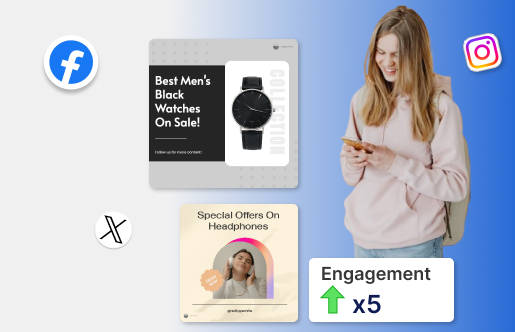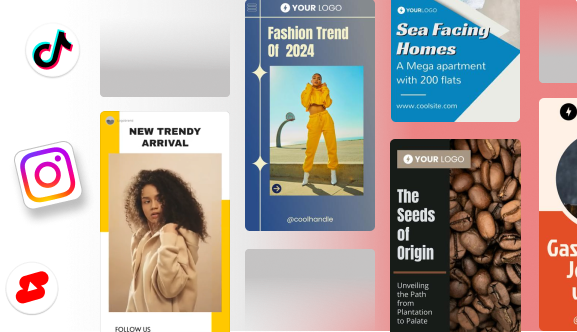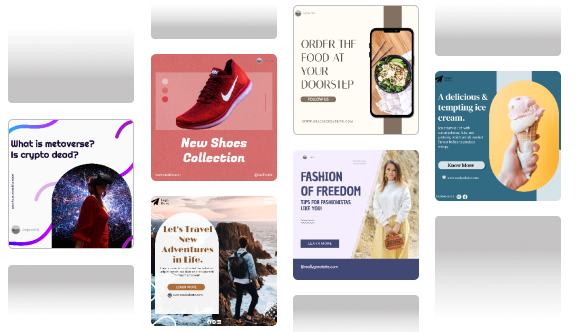Amid the vast digital realm, it is quite easy to lose yourself in content monotony and even easier to be overloaded with idle resources that are not put to the best use. This inevitably leads to drooping levels of viewer engagement and a drop in the quality of your content. To prevent this, you need clarity and structure. A key content category called “content bucket” makes for an ideal framework to help you plan and execute your content marketing strategy. The concept of content buckets involves bifurcation, categorization, and arrangement of content, and while often understated, content buckets for social media can play a vital role in streamlining your creative process.
This article will dive into a deep dive into content buckets, their relevance, and their advantages. To help you make the most of this feature, we will also cover a step-by-step guide on how to use content buckets for social media.
Excited? Let’s get right to it!
What are Content Buckets?
Before learning how to create one, let’s understand a little more about content buckets.
- Content buckets for social media are content groups or themes that serve as a framework or outline to organize your social media content.
- Using content buckets, your social media content strategy remains varied, balanced, and aligned with your overall goals.
- Simply put, content buckets are collections of ideas or themes that can be used to create content across social media platforms. By grouping similar content, you can ensure that your messaging is consistent, on-brand, and targeted toward your desired audience.
- Social media content buckets can include anything from general themes, such as industry news or product updates, to more specific ideas, like behind-the-scenes glimpses into your business or curated content from other sources.
- By creating these buckets, you can ensure that your content is varied and engaging, helping to keep your audience interested and coming back for more.

Tip: If you’re in the crypto space, understanding how content buckets work is key to building an effective crypto content marketing. It helps you organize educational, promotional, and community-focused content to reach the right audience efficiently.
Relevance and Scope of Content Buckets for Social Media
Did you know that 77% of customers prefer buying from a brand they follow on social media? With millions of users scrolling through their feeds every day, social media is an indispensable tool for marketing your business.
But with the ever-increasing number of social media platforms and content types, how do you create a content bucket social that can cut through the clutter and reach your target audience?
The answer lies in content buckets. Social media content buckets are an essential tool for businesses looking to build a strong, consistent presence across various social media channels.
The world of content marketing is constantly evolving; thus, there is a need to refine your strategy to lead your business to success. Here are some important facts and stats that you must learn about the current content marketing strategy:
- 46% of marketers and business owners agree that SEO leads to success in content marketing.
- Audience segmentation and creating content based on audience needs and preferences is critical, as 80% of marketers that use audience segmentation report increased sales
So, as a content creator, if you’re ready to take your social media strategy to the next level, read on to learn how to create a content bucket that will help you succeed in the ever-evolving landscape of social media marketing.

Why Should You Have Social Media Content Buckets?
Creating content buckets for social media is a strategic approach that offers several benefits for your overall content strategy. Here are key reasons why you should consider using content buckets:
- You can diversify your social media content by categorizing it into different themes or topics. This eliminates monotony and empowers your brand with updated and refreshing content.
- Content buckets allow you to maintain consistency in the types of content you share, which is crucial for building brand identity.
- You can create a balance between promotional and non-promotional content that will help align your social media efforts with your business goals.
- Content buckets enable you to cater to diverse audience interests so that your social media pages resonate with a broader range of followers.
- By offering a mix of content types, you increase the likelihood of engagement and interaction with your audience. It also allows you to optimize your content for search engines within the social media platform.
- Content buckets make it easier to track the performance of different types of content.
5 Ways in Which Social Media Content Buckets Can Benefit Your Business
If you’re looking to up your social media game, creating content buckets should be at the top of your to-do list.
Here are five ways in which social media content buckets can benefit your business:
1. Stay Organized
- Creating a content bucket makes it easy to stay organized and plan your content.
- By grouping similar themes or ideas, you can create a roadmap for your social media content, making it easier to produce high-quality content that aligns with your overall marketing strategy.
2. Be Consistent
- One of the most important aspects of social media is maintaining consistency in your messaging and branding. By using content buckets, you can ensure that your messaging stays on brand and is consistent across all your social media channels.
- This can help to build trust with your audience and establish your brand as a reliable source of information.
3. Interact and Engage
- Social media is all about engagement, and content buckets can help you produce content that resonates with your audience.
- By grouping similar ideas, you can focus on content that speaks directly to your audience’s interests and needs, helping to drive engagement and build a loyal following.
4. Be Flexible for Change
- Social media is an ever-changing landscape, and it’s important to be flexible and adaptable with your content.
- By using a content bucket, you can quickly pivot your content strategy, if necessary, without sacrificing your overall branding or messaging.
5. Save Time
- Creating high-quality social media content takes time, and using content buckets can help you make the most of the time you have.
- By planning your content and grouping similar ideas, you can produce high-quality content quickly and efficiently without sacrificing consistency or brand messaging.
Step-by-Step Process To Create Content Buckets For Social Media
A content bucket is a collection of similar ideas or themes that can be used to create consistent, high-quality content across all your social media channels.

Here’s a step-by-step process to help you develop a content bucket for social media:
Step 1: Define Your Target Audience
The first step in creating a content bucket is to define your target audience. It’s important to understand who your audience is, what they are interested in, what are their pain points, and what they are looking for.
You must align the content with your business goals for social media, such as increasing brand awareness, driving sales, or enhancing community engagement.
You can use tools like Google Analytics and social media analytics to get insights into your audience. By understanding your target audience, you can create content that speaks directly to their needs and interests.
Step 2: Understand Your Business
Before diving into content creation, you need to have a solid understanding of your business’s goals and values. What are you trying to achieve with your social media content? Whether it’s about building brand awareness, driving sales, or increasing community engagement. Understanding your business objectives helps guide the themes and tone of your content buckets.
Step 3: Brainstorm Content Ideas
The next step is to brainstorm content ideas that align with your target audience and business objectives.
Start by creating a list of topics that you want to cover, like polls, stories, Q&As, promotional content, user-generated content, and so on. Think about what your audience would be interested in, what problems they are facing, and what solutions you can offer.
Use tools like keyword research and social media analytics to identify popular topics and themes. This will give you an idea of what people are searching for and what topics are currently trending.
Step 4: Group Your Ideas into Themes
Once you have a list of content ideas, group them into themes or categories. For example, if you’re a fashion brand, you might have content buckets for seasonal trends, behind-the-scenes content, and product features.
The idea is to create a framework for your content that will make it easier to create and plan your social media content.
Step 5: Refine Your Buckets
Once you have your content buckets in place, it’s time to refine them. Make sure that your content bucket aligns with your overall marketing strategy and brand messaging. You may find that certain buckets aren’t as relevant as others or that you need to create new buckets to fill in any gaps.
Keep your target audience in mind when refining your buckets, and make sure that they are going to be interested in the content you are creating.
Step 6: Create a Content Calendar
With your content buckets in place, it’s time to create a content calendar. A content calendar is a schedule of when you’ll post each type of content.
This will help you stay organized and ensure that your content is consistent and targeted. Use a tool like Predis to schedule your content in advance. You can also use a spreadsheet to create a manual calendar.

Step 7: Create and Curate Content
The final step is to create and curate content that aligns with your content bucket. Make sure that the content you create is high-quality, engaging, and on-brand. Don’t be afraid to experiment with different types of content, such as videos, images, and infographics.
You can also curate content from other sources, such as industry influencers and other thought leaders in your space. Just make sure that the content you share aligns with your brand and messaging.
Step 8: Adapt Your Content Buckets Based on the Platforms You Use
Different platforms may require unique content approaches. Each social media platform has its unique strengths, so it’s important to tailor your content buckets accordingly. For example, Instagram is best suited for visual content like photos and short videos, while Twitter is great for brief, text-driven updates and real-time conversations. LinkedIn works well for thought leadership and professional insights, whereas YouTube is ideal for long-form video content. Adapting your content to the platform’s strengths ensures higher engagement and better results.
Step 9: Keep a Regular Check on Your Postings
You must keep a vigilant eye on different content buckets and adjust your strategy based on performance metrics. Regularly review analytics, engage with your audience, seek feedback, and maintain a consistent brand presence.
Create scroll-stopping content using Predis.ai, the only AI social media tool that creates social media posts from a simple text input. Create single-image posts, Instagram stories, videos, carousels, reels, and stories with Predis.ai.
Common Mistakes to Watch Out for When Creating Content Buckets
Content buckets can change your social media game, but only if you avoid these common mistakes. Focusing on the content without considering your audience and brand can be a trap. Let’s take a look at the mistakes to avoid when creating and managing content buckets:
Lack of Mix:
- One of the biggest mistakes you can make is sticking to just one type of content bucket, making your feed look predictable and boring. Your audience will get bored of seeing the same kind of posts over and over. By not mixing it up, you’re limiting your reach and appeal. Make sure you have a balanced mix of content types, educational, promotional, and user-generated content. Variety keeps your audience interested.
Inconsistent Branding:
- When using multiple content buckets, branding is key. Each post should reflect your brand’s voice, tone, and visual identity. Inconsistent branding confuses your audience and weakens your brand on social media. Make sure all posts, regardless of content type, stay true to your brand’s core values and messaging. That means a consistent color palette, typography, and language across all your buckets.
Ignoring Audience Preferences:
- A big mistake is creating content without considering what your audience wants. If your content buckets don’t align with your audience’s preferences, you’ll miss out on engagement. Use data, feedback, and social media analytics to understand your audience. Do they prefer how-to guides or behind-the-scenes content? Let the data guide your content creation, so it’s relevant and engaging.
Not Tracking Engagement Metrics:
- While creating content is important, tracking its performance is crucial. Many businesses make the mistake of not tracking different content buckets. Not all buckets will perform equally well, and that’s okay—as long as you use this data to improve. Check your metrics regularly, engagement rates, shares, and comments. If one type of content is underperforming, consider adjusting your approach or swapping it for a different bucket that resonates better with your audience.
So watch out! 😉 By avoiding these common mistakes, you’ll ensure that your content buckets serve as a powerful tool in your social media strategy, driving both engagement and brand consistency.
Real-Life Examples of Content Buckets for Creators
For content creators, using real-life examples can be incredibly helpful.
- For instance, a travel blogger might use content buckets like destination highlights, travel tips, and behind-the-scenes looks at their adventures.
- These categories help keep their content varied while maintaining a cohesive theme.
- Another example could be a fitness influencer who uses buckets like workout routines, healthy recipes, and motivational stories to engage with their audience.
15 Popular Content Bucket Types & Ideas for Social Media
The answer to this question will depend on your specific goals and audience, but generally, it’s recommended to have 3–5 content buckets. Having too few buckets can lead to repetitive and stale content, while having too many can dilute your brand messaging and confuse your audience.
Here are the most popular types of content buckets for social media:
1. Educational Content Buckets
These include how-to guides, tutorials, industry insights, or explanations of complex concepts. Additionally, content centered around industry news and trends helps consumers stay current, updated, and relevant.
2. Promotional Content Buckets
This highlights your products or services through promotions, discounts, and upcoming events. Business accounts need a framework for quick marketing approaches and promotional content buckets for social media are perfect to reduce the overall lead time without having to dilute the focus on other operations tasks.
3. Entertainment Content Buckets
These content buckets for social media are especially popular for delivering content such as memes, jokes, funny anecdotes, or lighthearted content to entertain your audience. In case your brand or account wants a focus on content that drives light-hearted reliability, this type is the ideal choice.
4. User-generated Content Buckets
UGC is a crucial part of organic lead generation. UGC content buckets for social media are created for your audience or followers to refer to. The main advantage of it is to encourage engagement and community building.
5. BTS Content Buckets (Behind The Scenres or Personal Content)
Social media platforms such as Instagram and Facebook have a feature called Reels and Stories. Behind-the-scenes content buckets are ideal for these features and involve footage of recent or ongoing events to showcase the human side of your brand.
Personal content focuses on humanizing your brand and building emotional connections with your audience. Personal content helps audiences relate to your brand on a deeper level, fostering loyalty and trust.
6. Inspirational Content Buckets
These include quotes, stories, or content that inspires and motivates your audience.
Inspirational content buckets include quotes, stories, and motivational messages that uplift your audience. These posts connect emotionally with followers by sharing personal achievements, success stories, or encouraging words. They humanize your brand and build loyalty by aligning with your audience’s values. For example, a fitness brand might share transformation stories to motivate followers.
7. Interactive Content Buckets
Interactive elements encourage audience participation and drive engagement. These interactive content buckets entail social media polls, quizzes, challenges, or interactive posts
Interactive content buckets encourage active participation from your audience, including polls, quizzes, and challenges. These posts drive engagement by inviting users to vote, comment, or join a challenge, creating a sense of involvement. Interactive content increases visibility and strengthens your connection with followers.
8. Customer Survey Content Buckets
This type is vital to building your brand’s credibility. Content types involved are reviews, feedback, success stories, and testimonials. The customer survey content bucket builds credibility through reviews, feedback, and testimonials. Sharing real customer experiences acts as social proof, reassuring potential buyers of your brand’s reliability. Surveys also provide valuable insights, helping you improve your offerings and engage your audience.
Similar to customer surveys, success stories provide evidence of how your brand has helped clients. Whether it’s a detailed case study or a short testimonial, this content highlights positive outcomes and showcases your brand’s ability to deliver results.
9. Conversational Content Bucket
A conversational content bucket encourages direct engagement with your audience. It invites your followers to join in discussions through polls, Q&A sessions, and live chats. This type of content is designed to spark interaction, helping you create a community around your brand. By asking questions or encouraging feedback, you can build stronger relationships with your audience and get valuable insights into their preferences and needs.
10. SEO Content Bucket
SEO content bucket is essential for boosting your online visibility. This type of content incorporates keywords, hashtags, and meta descriptions to improve your reach. By optimizing your social media posts for search engines, you can drive more traffic to your website and ensure that your brand is discoverable by the right audience. Whether through blog posts, social media updates, or product descriptions, SEO content helps improve rankings and make your brand more visible.
11. Product Content Bucket
Product content highlights your goods or services in a way that resonates with your target audience. Through product demonstrations, features, and benefits, this type of content showcases the value of what you offer. It helps to inform and persuade potential customers, guiding them toward making purchasing decisions.
12. Listicles and Tips Content Bucket
Listicles and tips provide quick, actionable insights that are easy for your audience to digest. This content type is often educational, offering useful information in a concise format. It’s also highly shareable, making it a great tool for driving engagement and increasing reach. This type of content positions your brand as an expert in your field, offering valuable insights that solve problems or answer common questions.
13. Facts and Figure-Based ( Statistical) Content Bucket
Data-driven content that includes facts, figures, and statistics can be very persuasive. This type of content helps establish your brand as a knowledgeable authority in your field. It’s especially useful in industries that rely on hard data to inform decisions.
14. Industry News or Trends Content Bucket
Keeping your audience updated with the latest industry trends and news is a great way to establish yourself as a thought leader. Whether you’re sharing reports, insights, or opinions, this type of content shows that your brand stays ahead of the curve.
15. Seasonal Content Bucket
Seasonal content is relevant to specific holidays, events, or seasons. By aligning your content with what’s happening in the world, you keep your messaging timely and engaging. Seasonal content can also tie into promotions, events, or sales to boost conversions.
While these are the most common and effective content buckets for social media, the framework can easily be customized to match your social media posting preferences and style.
Using such content buckets, you can create a well-rounded social media strategy that ensures your social media content strategy remains dynamic and aligned with evolving trends and audience preferences.

Content Buckets For Social Media Strategy
Integrating content buckets into your broader social media strategy enhances your ability to maintain consistency while delivering varied and relevant content. Here’s how you can effectively incorporate content buckets into your strategy:
1. Align Content Buckets With Your Marketing Goals:
Each content bucket should support your overall marketing objectives, whether that’s increasing brand awareness, driving sales, or building community engagement. Start by mapping out your goals and creating content buckets that align with these aims. For example, if increasing conversions is your goal, you might create buckets for product showcases, success stories, and promotional offers.
2. Use Consistent Messaging Across Platforms:
Consistency is key to building brand recognition, and content buckets help you deliver consistent messages across multiple platforms. While your tone and approach might vary slightly between platforms (e.g., Instagram being more visual and LinkedIn more professional), the core themes from your content buckets should remain the same. This helps reinforce your brand’s identity and message.
3. Efficient Content Creation:
Content buckets streamline the process of content creation. By pre-defining categories such as educational content, product promotions, or user-generated content, you can batch-create posts within each bucket. This saves time and ensures you always have a steady flow of content ready to publish. Tools like content calendars and scheduling apps can help you plan and distribute content from different buckets in advance.
4. Adapting to Platform Requirements:
Different platforms have unique formats and audiences, so while your content buckets remain consistent, the execution might change. For example, an educational post in your content bucket might take the form of a carousel on Instagram, a short video on TikTok, or an in-depth article on LinkedIn. Understanding platform-specific features and adapting your content accordingly ensures that it remains relevant and engaging.
5. Maintaining Variety While Staying On-Brand:
Content buckets prevent monotony by ensuring that your social media strategy includes a diverse range of posts. Rotating between buckets such as educational posts, promotional content, and behind-the-scenes glimpses, keeps your audience engaged without straying from your brand’s identity. This balance of variety and consistency makes it easier to retain audience interest.
6. Measuring Effectiveness and Iterating:
As you integrate content buckets into your strategy, continuously monitor their performance and be ready to adjust. Some buckets may overperform, while others may need to be re-evaluated or replaced. Regularly revisit your content bucket strategy to ensure it aligns with evolving business goals and audience preferences.
Incorporating content buckets into your social media strategy not only improves efficiency but also enhances your ability to deliver content that resonates with your audience. By aligning your buckets with your marketing goals and adapting them to each platform, you create a cohesive and dynamic content strategy that supports your brand’s growth.
Content Bucket Trends
Your audience is dynamic, and so should be your content buckets. The content strategy that works today might need tweaking tomorrow as trends change, audience preferences shift and new opportunities arise. Here’s how you can adapt and grow your content buckets over time:
- Trend Watch: Social media trends change fast and staying on top of them is key to keeping your content current. Whether it’s a new Instagram feature, viral challenges, or evolving content formats, pay attention to what’s trending in your industry. For example, if video content or short-form stories are taking off, you can create a new bucket for Reels or Stories to align with the trend.
- Social Listening: Social listening is tracking conversations happening around your brand and industry. By monitoring what your audience is saying and the questions they’re asking you can tailor your content to answer their questions. Social listening will give you insights into new topics, themes, or issues your audience cares about and you can adjust your content buckets to meet their needs.
- Analyze Regularly: Metrics such as engagement rates, shares, comments, and conversions will show you which content buckets are working and which need tweaking. Some buckets may drive more engagement, others may not be resonating as much. Use this data to optimize underperforming buckets or add new types of content that could deliver better results.
- Test New Ideas: Creating experimental content buckets based on recent events, audience feedback, or new industry trends can provide fresh content and test what your audience might like. For example, if you’re in the fitness industry and virtual workout sessions are taking off, create a temporary bucket for virtual fitness tips.

How Often Should You Review Your Content Buckets?
Consistency is key to a strong social media presence but so is updating and refreshing your approach. Here’s how often you should review and adjust your content buckets for long-term success:
- Quarterly Review: Set aside time every quarter to review your content buckets. Look at engagement metrics, audience feedback, and overall performance to see what’s working and what’s not. If you notice certain buckets are driving traffic, engagement or sales consider doubling down on those. If a bucket is underperforming you might need to modify it or even replace it with a better type of content.
- After Major Campaigns: Once you’ve finished a major campaign you need to review how well it resonated with your audience. Did the content bucket you created for that campaign work? Were there gaps in the strategy? Use this insight to refine or update your content buckets so future campaigns are even more successful.
- When Your Audience Changes: As your business grows your audience may change and with it their interests and needs. Keep an eye on your audience demographics and preferences. If there’s a big shift – for example, you start getting a younger audience – you may need to adjust your content buckets to cater to new interests and behavior patterns. Reviewing your audience data regularly helps ensure your content stays relevant to who they are.
Tracking and Analyzing Content Bucket Performance
To get the most out of your content buckets, it’s essential to track and analyze content buckets’ performance regularly. Simply posting content isn’t enough; you need to ensure that your content resonates with your audience and drives the desired results. Here are key metrics and methods to help you analyze the effectiveness of your content buckets:
1. Engagement Rates:
One of the most critical indicators of how well your content is performing is engagement. This includes likes, comments, shares, and saves on platforms like Instagram, Facebook, and Twitter. High engagement shows that your audience finds the content valuable and relatable. Review engagement data for each content bucket to see which themes are encouraging more interactions.
2. Click-Through Rates (CTR):
CTR measures the percentage of users who clicked on a link in your post compared to the total number of users who viewed the post. It’s a valuable metric for understanding how effective your content buckets are at driving traffic to your website, landing pages, or product pages. Analyze which buckets, such as promotional content or how-to guides, are leading users to take action.
3. Conversions:
Conversion tracking is essential for determining the ROI of your content efforts. Whether the goal is sales, sign-ups, or downloads, tracking how many users complete your desired actions after engaging with your content provides insights into which buckets deliver the highest returns. For instance, you might find that success stories or testimonial-based content have the highest conversion rate, helping build trust and credibility.
4. Audience Demographics and Reach:
Review analytics to understand which content buckets appeal most to specific audience segments. Different buckets may resonate with varying age groups, locations, or interests. Platforms like Instagram and Facebook offer detailed demographic data, allowing you to refine your strategy to target the right audience with the right content.
5. Content Longevity:
Some content types have longer lifespans than others. For example, evergreen content such as educational guides may continue to attract views and engagement long after being posted, while promotional content may see short bursts of engagement. Analyzing the longevity of each content bucket helps you understand which themes provide ongoing value and which require frequent updates.
Social Listening and Feedback: In addition to tracking quantitative metrics, pay attention to qualitative feedback. Social listening tools can help you understand how your audience talks about your brand and the types of content they share. Comments, direct messages, and surveys also provide valuable insights into which content buckets are hitting the mark.
By regularly analyzing these metrics, you can identify trends in what’s working and what’s not. This allows you to optimize your content buckets by refining the ones that resonate most with your audience and adjusting or eliminating underperforming content types.
Top Real Life Examples of Content Buckets
Let’s see how well-known brands are using content buckets to create diverse social media strategies.
1. Starbucks
Starbucks is great at categorizing content into buckets that keep their audience engaged. They focus on seasonal promotions (e.g. Pumpkin Spice Latte), customer stories, and user-generated content, so they create both promotional and engaging content. This variety helps them have a consistent yet varied presence across their social media platforms and keeps customers excited about the brand.
2. Nike
Nike uses content buckets to tell a story. They focus on athlete stories, new product launches, and user-generated content (UGC) that shows how real people use their products. By mixing emotional storytelling with promotional content they keep their messaging strong and the audience engaged with different types of content.
3. GoPro
GoPro uses content buckets to maximize user-generated content. With a focus on adventure, tutorials, and contests GoPro taps into their community’s experiences, shows the products in action, and lets customers tell the brand’s story. Their focus on UGC ensures authentic content, boosts audience engagement, and builds a loyal customer base.
By observing these case studies, you can see how successful brands use content buckets to organize their social media strategies, maintaining balance and maximizing audience engagement.
Conclusion
Creating content buckets for social media is an effective way to stay organized and on-brand with your content. Through the advantages that we’ve covered, the potential for streamlining and improving the quality of your content is clear.
While this blog’s step-by-step process for creating content buckets helps you blend your strong and engaging social media presence, it is important to remember that creating content buckets is not a one-time process.
Using the tools on Predis.ai‘s AI-powered platform, you can create stunning content with eye-grabbing visuals.
Predis.ai also offers an in-built Competitor Analysis feature to help you keep track of competition in your industry.
So, what are you waiting for? Start creating your content buckets and watch your social media presence grow!
Use Predis.ai Social Media Post Generator, as it offers access to over 10,000+ templates and creates content for your content bucket with just a few clicks.
FAQs
Social media content buckets are groups or categories of content that help structure your social media strategy. They allow you to organize ideas into themes, ensuring that your content is varied, engaging, and aligned with your goals.
To create a content bucket, define your target audience, brainstorm content ideas, group them into themes, and narrow them down to focus on the most important aspects. This helps you maintain consistency while keeping your content diverse.
Content pillars are the core themes that align with your brand’s mission and overall strategy, while content buckets are the specific types of content that fall under these pillars. Pillars are broad themes, whereas buckets are more granular.
Organize your content by creating a calendar that outlines your content buckets and aligns with your posting schedule. This ensures consistency and helps you track which types of content perform best.

















